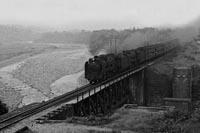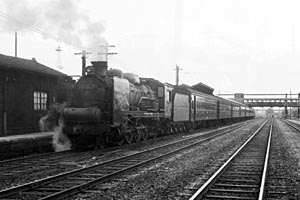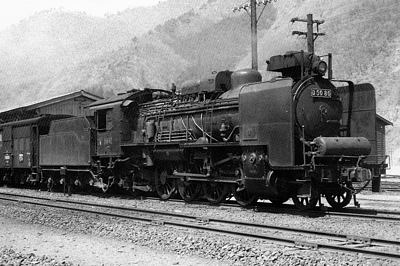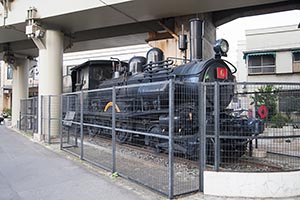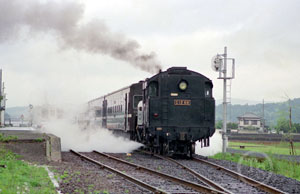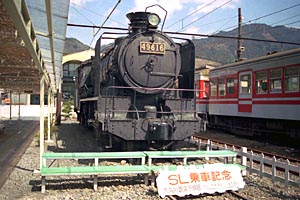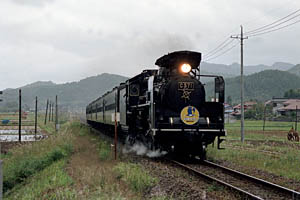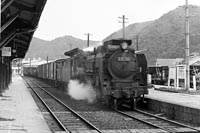The new schedule was updated on 10th of Jun 2022
Index
[ About official site link ]
If there is an official English page, my website is linked to the English page.
If there is no English page, OR even if there is an English page, but the page has no present steam train information, my site is linked to the Japanese page.
|
|
East Japan Railway Company
|
| SL Gunma Minakami
|
|

D51_498 leaves Minakami station,
during May 1995.
|
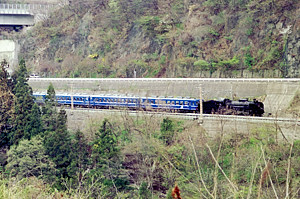
Near Minakami, during May 1996.
|
* Photo of Steam's Working days *
Takasaki depot 1967.
|
The Jouetsu line is the arterious line which a part of connects Tokyo and Niigata.
It was fully opened during September 1931 with the opening of the long 9 Km Shimizu tunnel.
It was the longest tunnel in Japan at that time.
The tunnel section, between Minakami and Echigo-Yuzawa (Ishiuchi) station was opened with electrification from its very beginning.
Other sections, between Takasaki and Minakami,
and Echigo-Yuzawa to Nagaoka were operated by the Takasaki and Nagaoka depot's steam engines Class D50, D51 and C57,
but they were retired early during 1947s more expansive electrification.
During 1982, Jouetsu Shinkansen opened, Jouetsu line lost it's arterious line position.
The revived steam train saw service from December 1988 with D51_498 as the Jouetsu area's sightseeing attraction.
The Minakami area has a large number of tourists during any time of the year and season,
with mountain climbing, skiing, viewing colorful autumn leaves and hot springs.
|

| Switching in Minakami station 1995.
| 
| Near Minakami 1996.
|
| Service
| JR East, Jyoetu line, Takasaki - Minakami
|
| Steam Engine
|
D51_498, C61_20
|
| Official site
| JR East
|
| Date of Service 2022
|
| July : 22 24 29 30
| August : 6 11 14 20
| September : 18 23 25
|
|
|
| SL Gunma Yokokawa
|
|
|
* Photo of Steam's Working days *
Doubleheader D51 on the Shinetsu line
Matsuida Jul 1958
(Photo credit to S.Sumino)
|
The Shinetsu line between Takasaki and Niigata was fully opened during April 1893 as a connection
between Tokyo and Niigata through Takasaki, Yokokawa, Karuizawa, Nagano, Naoetsu, Nagaoka and Niitsu.
The first opened part was Takasaki to Yokokawa during October 1885.
Between Yokokawa and Karuizawa was first electrified as a Japanese main line during May 1912.
(Consult please Saitama Railway museum's ED40_10)
But during September 1931, after Jouetsu line opened,
Shinetsu line ended a role of connection between Tokyo and Niigata city,
and the line role changed to connect Tokyo and Hokuriku area through Nagano.
The mainly used steam engines during 1960's were ;
Takasaki - Yokokawa ..... Takasaki depot's class D50 D51
Karuizawa - Naoetsu .... Ueda, Nagano and Naoetsu depot's class D50 D51
Naoetsu - Niigata ... Naoetsu, Nagaoka, Niitsu and Niigata depot's class D50 D51 C51 C57
(Yokokawa - Karuizawa ... Yokokawa depot's class ED42 electric locomotive)
These steams were abolished by electrification as follows ;
Nagaoka - Niigata .... May 1962, Takasaki - Yokokawa ..... July 1962, Karuizawa - Nagano .... Jun 1963,
Nagano -Naoetsu .... Aug 1966, Naoetsu - Nagaoka .... Aug 1969
During October 1997, Yokokawa - Karuizawa section was closed with the Nagano Shinkansen opening, herewith,
Shinetsu line was split into two sections as Takasaki - Yokokawa and Karuizawa - Nagano - Niigata.
And also Karuizawa - Nagano (Shinonoi) section was relegated to the third-sector company of Shinano-Tetsudo.
During April 1999, revived steam train service started between Takasaki and Yokokawa with the opening of
the ' Usui Tetsudo Bunka mura ' railway museum on the site of the Yokokawa depot.
|
| Service
| JR-East Shinetsu line, Takasaki - Yokokawa
|
| Steam Engine
| D51_498 C61_20
|
| Official site
| JR East
|
| Date of Service 2022
|
| July : 11 25
| August : 15 30
| September : 13 20 26
|
|
SL Banetsu Monogatari
(Steam Train, the Story of Banetsu)
* Photo of Steam's Working days *
Banetsu-sai line Mar 1960
D50_261 at the Koriyama station
(Photo credit to S.Sumino)
|
The West-Banetsu line connects Fukushima and Niigata prefecture, and was opened during November of 1914.
The line ran between Koriyama and Niitsu, but the service was separated midway of Aizu-Wakamatsu.
During the 1960s, the line was operated by the Aizu-Wakamatsu depot's steam D50 D51s, and the Niitsu depot's C57 D51s.
On the 15th of June 1967, the section of the Koriyama - Aizu Wakamatsu - Kitakata saw electrification,
and steam trains were retired on this section.
Between Aizu-Wakamatsu and Niitsu dieselization occurred during September 1969,
but a few steam freight trains were left up to September 1972.
The revived steam train started service from the 29th of April 1999 with the C57_180.
There are many famous sightseeing spots around the beautiful castle town of Aizu-Wakamatsu .....
such as, Mt. Bandai, Lake Inawashiro ..... tourists can also enjoy the trip on that steam train.
|
|
| Service
| JR-East Banetsu-Sai line, Aizu Wakamatsu - Niigata
|
| Steam Engine
| C57 180
|
| Official site
| JR East
|
| Date of Service 2022
|
| June : 5 11 12 18 19 25 26
| July : 2 3 9 10 16 17 23 24 30 31
| August : 6 7 11 13 14 20 21 27 28
| September : 3 4 10 11 17 18 24 25
| |
|
SL Ginga
(Steam Train, The Milky Way)
* Photo of Steam's Working days *
D50_80 Rikuchu-Ohashi, Kamaishi line
Apr 1960
(Photo credit to S.Sumino)
|
The Kamaishi line is the 90 kilometers which connects Iwate prefecture's inland Hanamaki on the Tohoku line and the coastal city of Kamaishi.
In the beginning, at the eastern part (Kamaishi end) of the Kamaishi line during 1880, Kamaishi Mine Railway was built in order to connect the Kamaishi ironworks and the Kamaishi mine.
The western part (Hanamaki end) of the Kamaishi line was opened during 1915 as the Iwate Keiben Railway.
At the 10th of October 1950, Kamaishi line was fully opened on the East and West line connection through the regauged (762mm => 1067mm) and nationalization process.
The Kamaishi line was used by Kamaishi depot's class D50 around its opening days, but D50s were slowly replaced with D51 from 1960.
All Kamaishi line steams were replaced with diesel engine DD51's during March of 1967, and the steam service was finished. At that last time, Kamaishi depot's steam engine's were almost fifty-fifty percent of D50 and D51.
Afterward, the special event train saw service once nearly every year during 1989 to 2004 by D51_498.
Kamaishi city received crushing damage during the East Japan great earthquake tsunami disaster of 11th March 2011.
Kamaishi line also received big damage, but all was restored during April, 2011.
The "SL Milky Way Dream" was run as Kamaishi revival prayer during June of 2012.
After this performance, regular steam train service was begun with the "SL Milky Way" by the newly restored C58_239 from April of 12, 2014.
The nickname of Kamaishi line is the "Milky Way Dream Line".
And also the steam train nicknamed, the "SL Ginga (Galaxy)".
This line and train's name came from the famous author of Tohoku, Kenji Miyazawa,
his most famous title of the novel "Ginga Tetsudo no Yoru. (Night on the Milky Way Railroad, or Night on the Galactic Railroad)".
This novel is said to be a model of the Iwate Keiben Railway.
|
|
| Service
| JR-East Kamaishi line, Hanamaki - Kamaishi
|
| Steam Engine
| C58_239
|
| Official site
| JR East
|
| Date of Service 2022
|
Hanamaki to Kamaishi (Down train) ;
| June : | 4 11 18 25
| July : | 2 9 16 23 30
| August : | 6 11 14 20 27
| September : | 10 17 24
| |
| Kamaishi to Hanamaki (Up train) ;
| June : | 5 12 19 26
| July : | 3 10 18 24 31
| August : | 7 12 15 21 28
| September : | 11 19 25
| |
| | |
The Tobu Railway Co. is the largest private railroad company which owns the second longest line in Japan except the JR groups, and it was opened during August 1899.
Tobu Railway became an acquisition target by the "Railway Nationalization Act" during 1906, but, Tobu was not acquired, because Tobu formed a Narrow gauge railroad company.
(A Narrow gauge company was not listed under coverage of the Nationalization Act.)
Afterward, Tobu absorbed many small private railway companies, and it became the greatest private railroad company in the Kanto area.
All of Tobu Railway steams were retired during July 1966 with a freight train on the Sano line.
Up to that day, Tobu had a total of 85 steam engines. Many of them were of the 4-4-0 tender engine type which had a good showing during Japan's main line service during the Meiji Period. (until 1912)
During those days, we steam fans called "The kingdom of steam locomotives", because many classic engines were still active by Tobu during the 1960s.
Steam Engine deployment list during 1949 (S = Sobu)
| Depot | Engine number | Total
| | Sugito | 26 41-47 56 60-64 C112 | 15
| | Asakusa | S6 S7 22-25 48 | 7
| | Tatebayashi | 1 S5 3-7 27 28 30-34 49 50 | 16
| | Kawagoe | 10 13 16 29 35-40 54 55 | 12
| | Shin-Takatoku | 8 58 59 | 3
| | Total | 53
|
Of these a few engines are preserved.
Preserved Tobu Railway's steam engine list during 2017
Engine
number | Builder | Serial | Year | Order | Tobu Retired | Currently preserved location
| | 1 | Koppel | 5885 | 1912 | Arita RW | 1952 | Itabashi, Tokyo
| | 5 | Beyer Peacock | 4028 | 1898 | Tobu RW | 1965 | Sumida, Tokyo
| | 6 | Beyer Peacock | 4029 | 1898 | Tobu RW | 1965 | Sumida, Tokyo
| | 34 | Beyer Peacock | 5841 | 1914 | Tobu RW | 1966 | Oota, Tokyo
| | 37 | Sharp Stewart | 4435 | 1898 | Nippon RW 209 | 1965 | Individual, Chiba
| | 39 | Sharp Stewart | 4437 | 1898 | Nippon RW 211 | 1966 | Freight train museum, Mie
| | 40 | Sharp Stewart | 4438 | 1898 | Nippon RW 212 | 1966 | Miyashiro, Saitama
| | 58 | Nippon Syaryo | 40 | 1921 | Utunomiya Sekizai 2 | 1939 | Omocha-no-machi, Tochigi
|
For your information, the same class C11 was registered in the past.
| Engine | Builder | Serial | Year | Orderer | Retired
| | C112 | Nippon Syaryo | 1331 | 1944 | Okutama Denki RW | 1963 scrapped
|
|
|
No.6 Sumida-ku, Tokyo, Oct 2009.
|
ex Tobu No.58 (Kanto RW No.5),
During Kanto Railway time, Aug 1969
Taiju
| |
|
The Tobu Railway restored steam train service and started on the 10th of August during 2017. This train was named "The Taiju". (The Great tree)
The steam train made the 12.4 kilometer run in 35 minutes between Shimo-Imaichi and Kinugawa-Onsen on the Tobu-Kinugawa line.The engine was leased from JR-Hokkaido's class C11 No 207.
And the turntables were placed from JR-West during March of 2017. These turntables were transferred from JR-West's Nagato and Miyoshi, and were installed at the Shimo-Imaichi and Kinugawa-Onsen stations.
A test operation was begun during May 2017, and a "Taiju" train was put into service to provide rides on practically all weekends and during national holidays after August 2017.
Tobu Railway purchased C11_325 from the Moka Railway during July 2020.
During April 2022, new engine ex-Yubetu Railway's C11_1 was added, and it was named C11_123.
|
| |
|
| Service
| Tobu Nikko line, Shimo-Imaichi - Tobu-Nikko
|
Date of Service
June 2022
|
| June : | 8 24 27
| July : | 1 4 8 12 13 15 19-23 25-29
|
|
|
| |
|
|
|
The Moka Railway Company's history is very old.
Originally, it first opened between Shimodate and Moka on the 1st of April 1912,
as the Moka Narrow Gauge Railway, and fully opened between Shimodate and Motegi during December 1920.
During 1954, all passenger trains were dieselized.
Afterward, Moka line's steam saw service only as freight trains by the Oyama depot's C12.
And all steam were retired during March 1970.
During September 1984, JNR decided on the closing of the Moka line which was in the red.
Afterward, Moka line was inherited from the JNR by the JR-East,
JR-East decided on the restart of the Moka line as a third-sector company.
Therefore, Moka Railway company was established on the 11th of April 1988.
The Moka Railway started the Restored Steam Train "SL Moka"
from the 27th of March 1994 with the C12_66 as the Mashiko area's (the town famous for pottery) sightseeing attraction.
|
|
| Moka Railway
|
|
C12_66 Steam train after restoration during 1988.
|
C12_66
|
|
| Service
| Moka Railway,Shimodate - Mashiko
|
| Steam Engine
|
C12_66
|
| Official site
| Moka Railway (Japanese)
|
Date of Service
2022
|
| June : | 4 5 11 12 18 19 25 26
| July : | 2 3 9 10 16 17 23 24 30 31
| August : | 6 7 13-15 20 21 27 28
| September : | 3 4 10 11 17 18 24 25
| October : | 1 2 8 9 15 16 22 23 29 30
| November : | 5 6 12 13 19 20 26 27
| December : | 3 4 10 11 17 18 24 25
|
| | | |
|
|

| C12-66 during 1987.
| 
| C12_66 in 1988.
|
|
In the Kanto's mid-sized private railroad, the Chichibu Railway's first section, between Kumagaya and Yorii was opened on the 7th of October 1901.
Originally the company was started as the Jobu Railway Co. with one C-Tank steam engine (Chichibu Railway's No.1, manufactured by Dubs Co.).
The company name was changed to the Chichibu Railway Co. during March 1916.
Chichibu Railway had a total of thirteen steam engines (Two were borrowed) in nine classes.
Chichibu Railway was electrified during 1922, at this time, the company owned six steam engines.
These engines were retired by 1923, and sold or transferred to other railway companies.
But a few engines remained as spare engines up to Jun 1934.
Electric railway company's Chichibu Railway didn't have steam engines for the next 54 years.
Half a century later, a restored steam train was started from March 1988 by the C58_363.
The train saw service between Kumagaya and Mitsumineguchi section.
The nearest working condition steam engine from Tokyo is the Paleo-Express.
There are many beauty spots on the "Nagatoro" river bank along the railroad line.
|
|
|
| Service
| Chichibu Railway,Kumagaya - Mitumine Guchi
|
| Steam Engine
| C58_363
| Official site
| Chichibu Railway (English)
|
| Date of Service 2022
|
| June : | 3-5 11 12 18 19 25 26
| July : | 2 3 9 10 16-18 20 22-24 29-31
| August : | 5-7 11-15 19-21 26-28
| September : | 3 4 17-19 23-25
| October : | 1 2 8-10 15 16 22 23 29 30
| November : | 3-6 12-14 18-20 23 25-27
| December : | 3 4
|
| | | |
|
| |
|
The Oigawa Railway Company was Shizuoka prefecture's private railway company, and was established during 1925.
The Oigawa Railway has two lines, one is the Oigawa main line between Kanaya on the Tokaido line and Senzu,
another line is the Ikawa line between Senzu and Ikawa.
Restored steam trains saw service on the Oigawa main line.
The Oigawa line was fully opened during December 1931, and a total of five steam engines were active up to 1950.
Oigawa lines electrification was completed during December 1949, and started electric locomotive trains.
Afterward, passenger train services gradually changed to electric car trains from August 1951.
The Oigawa Railway began collecting historical vehicles from around 1970.
These were gathered and preserved at the Senzu yard, and of these, some engines were restored.
They were ; Class 2100 No.2109 (Currently, it is kept in the college of the Nippon Institute of Technology),
Class 10 No.15 (Currently preserved at the Numata town museum in Hokkaido),
Class 1275 No.1275 (Currently, preserved at the Plaza Loco SL Museum near Shin-Kanaya station).
They saw service as short-range steam trains.
These trains probably saw Test-Runs before beginning full train service.
During 1976, Oigawa Railway bought a C11-227 from JNR.
Restored steam train full services were started on the 9th of July 1976.
This was the main line's first revived steam train service by a private railway company.
At the present time, Oigawa Railway has five engines in four classes
(One engine, C12_164 was entrusted from another company, and it's out of service at the present time.).
This number of steam engines are the largest in Japan except for JR Umekoji museum.
Before, there was one more reactivated engine, Class C11 No.312, but she was retired during September 2007.
The Oigawa Railway has regular steam service runs, almost daily, during the summer and other seasonal holidays.
|
|
|
|
C11 during 1988
|
Inactive-preservation engine Class 9600 No.49616
Senzu yard.
|
|
| Service
| Oigawa Railway,Kanaya - Senzu
|
| Steam Engine
|
C10_8,
C11_190,
C11_227,
C56_44,
|
| Official site
| Oigawa Railway Co. (English)
|
|
Date of Service 2022
|
| June : | 17-20 24-27
| July : | 1-4 15-18 22-25 29-31
| August : | 1 5-15 19-22
| September : | 2-5 9-12 16-19 22-25
| |
|
|

| C11 in 1986.
|
|
|
West Japan Railway Company
|
|
| SL Yamaguchi
|
|
Here we see a C57_1
after reactivated during 1986 near Tsuwano.
|
The Markings of the "SL Yamaguchi"
on its head.
|
|
* Photo of Steam's Working days *
D51-194 Yamaguchi station during 1970 |
Yamaguchi line has the most famous revived steam train in Japan and it is running in Yamaguchi prefecture.
The Yamaguchi line is the sub-main line which connects Yamaguchi prefecture's
Shin-Yamaguchi station and Shimane prefecture's Masuda station.
There are two very popular destinations for tourists in the Yamaguchi area, they are Tsuwano and Hagi city. Both are old quiet castle towns.
Additionally, nearby, there is Japan's largest limestone cave "Shuhodo".
The steam trains name is the " SL Yamaguchi" and it makes the 62.9 kilometer run in 2 hours between Shin-Yamaguchi and Tsuwano on the Yamaguchi line.
The Original Yamaguchi line was a narrow gauged private railroad company.
It was called the "Dai-Nippon-Kido Co. Yamaguchi" between Shinmachi and Yuda, and it was opened during October 1908.
But, this small railway was closed when the government railway Yamaguch line between Ogori and Yamaguchi was opened during February 1913.
Later, JGR Yamaguchi line was fully opened on the 1st of April 1923.
After WW2, Yamaguchi line saw service by Tsuwano depot's class D60s, but they were replaced by the class D51 during 1966. (You can see the preserved first D60 in the Yamaguchi Museum even now.)
A while later, Yamaguchi line's steam operations with D51s all disappeared by the 30th of September 1973.
In August 1979 a revived steam train was put into service to provide rides on practically all weekends.
After Japan's regular steam operation was closed, this was the first case of a steam train being revived in Japan.
The service was started by Umekoji museum's class C57 No.1.
2019 is the 40th anniversary for steam train restoration.
|
|
| Service
| JR-West, Yamaguch line, Shin Yamaguch - Tsuwano
|
| Steam Engine
|
| Official site
| Yamaguchi prefecture Steam Train bureau. (Japanese)
|
| Date of Service 2022
|
| Undecided (Service start after 16th July)
|
| |
|

| Near Oghori C571 1986.
| 
| Near Tuwano C571 1986.
|
|
|
SL Hitoyoshi
* Photo of Steam's Working days *
58654 at the Hitoyoshi depot.
During Mar 1974.
(Photo credit to Nicholas Pertwee)
|
The first partial current Hisatsu line was opened during September 1903 between Kagoshima - Kokubu (Currently Hayato) and Yoshimatsu as the Kagoshima line.
From the other end, the northern part of Kyushu between Moji - Kumamoto - Yatsushiro and Hitoyoshi section was opened during June 1908 as the Hitoyoshi line.
During November 1909, a remaining part between Hitoyoshi and Yoshimatsu was opened.
From this opening, the Kagoshima line between Moji and Kagoshima was fully opened as a connection between the northern city of Moji and the southern city of Kagoshima through Hitoyoshi in Kyushu,
and the Hitoyoshi line was renamed to the Kagoshima main line.
During October 1927, the coastal line between Yatsushiro - Sendai and Kagoshima route was opened.
The Kagoshima main line route was changed to the route of Moji - Yatsushiro - Sendai - and Kagoshima. And the Hitoyoshi route was renamed to the Hisatsu line at the same time.
During December 1932, between Kagoshima and Hayato (Renamed from Kokubu on Sept 1931.) the section of the Hisatsu line was rearranged to the Nippo line.
With this, Hisatsu line became the same as the current route of Yatsushiro - Hitoyoshi - Yoshimatsu - Hayato.
The Hisatsu line's steam locomotive was used a class 8620 systematically for a long time, with a base of Hitoyoshi and Yoshimatsu depot.
Therefore, it has profound significance in using the 8620 for service of the ' SL Hitoyoshi '.
After the 1950's, a larger-sized engine has been assigned, like C51 to the Yoshimatsu, D51 to the Hitoyoshi depot.
During the 1960's, C51 was replaced with C55, and the 8620 surplus, however, decreased during the late 1960s.
During the 1970's, C57 entered, as well as C55, but several 8620's were still left.
The last Hisatsu line steam disappeared at that time, Yatsushiro - Hitoyoshi - Yoshimatsu section was April 1972, Yoshimatsu - Hayato was March 1973.
And the class that survived till the last day were the main line D51, C55, and C57.
(Branch line C12, C56 and 8620 were used until 1975.) Of these that survived, one class 8620, 58654 was restored.
After the 3rd of July 2020, SL Hitoyoshi service was canceled for the time being due to damage by the flood of the Kuma-River.
Hisatsu line has no prospects of reopening. So, service section was changed to between Tosu and Kumamoto on the Kagoshima line.
|
|
| Service
| JR-Kyushu Kagosima line,Tosu - Kumamoto
|
| Steam Engine
| 58654
| Official site
| JR Kyushu (Japanese)
| Date of Service 2022
|
| June : 4 5 11 12 18 19 25 26
| July : 2 3 9 10 16-18 23-26 29-31
| August : 1 2 5-8 11-15 18-22 25-29
|
| |
| | |
|
|

Restored Steam Engine

|









